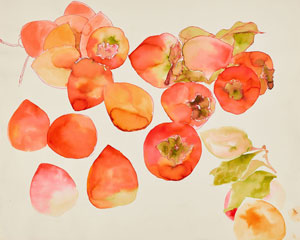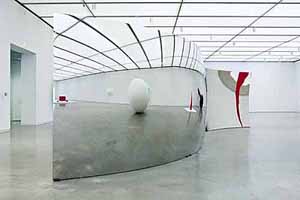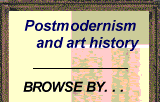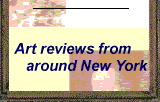The Horror
John Haberin New York City
Anish Kapoor's Early Work and Ruth Asawa
"Perhaps it is a modernist horror, but I have a horror of composition." Perhaps, but Anish Kapoor has a way of keeping one wary of what is to come and welcoming it all the same, in an art of layers and shadows. As Colonel Kurtz put it Heart of Darkness, the novella by Joseph Conrad, "The Horror! The Horror!"
An older sculptor, Ruth Asawa, fostered a sense of community. She celebrated it as a neighbor and teacher. She relied on it as a family member and in her art. How ironic, then, that this country did everything it could to deny her a place to live, to love, and to work. Twelve years after her death in 2013,  the Museum of Modern Art is still making amends. Kapoor is more likely to keep you fearing, and I return to him in a moment at the Jewish Museum, but first a word on Asawa.
the Museum of Modern Art is still making amends. Kapoor is more likely to keep you fearing, and I return to him in a moment at the Jewish Museum, but first a word on Asawa.
Born in 1926 in California to Japanese parents, she attended Black Mountain College in North Carolina, where she studied with Josef Albers, himself an immigrant. The Bauhaus veteran was more than a teacher, too—not just keeping the cause live, but a guide to art and life. Asawa learned from and grew close to his wife, Anni Albers, as well. The internment of Japanese Americans in World War II quickly upset her plans, and it was not until 1949 that she found a home in the Bay Area once again. She brought with her the decorative formalism of her student years in works on paper, but even so it took new laws before she could marry an American. She had to leave the country to find herself.
The breakthrough came on a trip to central Mexico, where she discovered wire basketry and resolved to learn the craft. She repeated ever after that the key to art was doing. Doing in turn meant a back and forth among painting, drawing, and sculpture. It was, at least at first, also a back and forth between forms of abstract art. She has been known ever since, though, for the wire twists. She kept work on paper largely in reserve as a source of color.
Loop the loop
Sculpture for her could only be handmade, in layer upon layer of black wire loops. The curators, led by MoMA's Cara Manes and Janet Bishop of SF MOMA, speak of the repetitive in what soon becomes a litany of commands—cascade, nestle, ruffle, interlock. The parallel to gestural abstraction in postwar American art is no coincidence. It was simple and symmetrical all the same, with little in the way of industrial welding. When Ruth Asawa does depart from wire, she turns instead to ceramic or bronze. More than famed sculptors like David Smith, she was a traditionalist at heart.
What begins with ordinary bowls becomes stacked and nested bulges, hanging from the ceiling as they build toward the vertical. Asawa spoke of sculpture as an opening—opening in or out. Art for her is a study in space, darkening, transparency, and motion. Inner bulges become visible through the open wire surface. Outer ones appear to twist and turn as one circulates, even as they hang perfectly still. There is no sparing the handmade.
It is more playful and personal than you may expect. Bronzes include frogs, feet, and portrait faces of family and friends. Regardless, there is no getting around the dogmatic and repetitive. The verticals look suspiciously like clothing store mannequins, with bulges for breasts and hips waiting for someone to dress them up. A composition from her earliest and strongest years cannot resist spelling everything out, Untitled (S.535, Hanging Five-Lobed Continuous Form within a Form with Spheres in the First and Fourth Lobes and a Teardrop Form in the Third Lobe. Did she miss anything? (And see, it is still untitled, honest.)
And yet something changes: the back and forth between paper and wire becomes a give and take between nature and art. The fluid character of watercolor speaks more and more for nature. She draws chairs, but she has a particular fondness for desert species and botanic forms—chrysanthemums and hydrangeas. Her Zen Buddhist upbringing gives her a lasting respect for calligraphy. It allows her a Garden of Remembrance in the sun.
And then there is the matter of community. She offers her home as a place for fellow artists to join her in the act of creation. She sees her job as a teacher as about remembering and creating as well. She is concerned not just with imagery, but also with a place of learning, a site. She found models for collaboration in mathematics and dance. California here she comes.
Suspicious? Proposed sites in work on paper look straight out of preschool or MoMA PS1. Her youthful density of mass, light, and motion seems increasingly left behind. One may come to doubt how vital it was all along. Her early obstacles in racism were real, though, and so was her defiance. Both are wrapped up in her experience of America. Not everything is encouraging, but enough of it loops the loop.
Celebrate the void
Few artists bring bare curves, intense color, and sheer blackness to sculpture and drawing more memorably than Anish Kapoor. Much of his mature work is monumental, even as it seems to dissolve before one's eyes. Just how he got from a gut sense of objects within the field of vision to a reinvention of both is the story of his early work at the Jewish Museum. When it comes the horror, he could be speaking from personal experience. For him, though, it could also be a reason to celebrate. Where past reviews have looked at Kapoor in greater depth as a whole, allow me to focus here on the work at hand. 
Like Colonel Kurtz, Kapoor makes the horror of spaces and things vivid and bright. Initially, though, it was also knowingly out of control. Early works on paper include simple shapes spiking, bulging, showering, and erupting outward. The multiplicity of thin curves might almost pose a threat. He sticks to red, black, and the white of the page against red as windows onto something greater. Titles speak of the Non Object and The Void.
Another title begins As If to Celebrate, and he may well distrust his own instincts along with the object, the big if. When he turns to sculpture, he sets out layered squares and pyramids, and cylinders in black or primary colors, with splashes of the same colors to every side. The room itself could be space or sculpture—as another title has it, Its Volume Revealed. Only later, after this show ends, does sculpture reach the epic proportions of public spaces and begin to float, as with Kapoor in the city's parks in 2017. Works on paper include crescent moons. All along, though, the object or void depends on its physical shadows, within or beneath.
This is a notably modernist horror, the horror of Minimalism, but a biomorphic one as well—as with Asawa in much the same years. That includes The Mother as a Mountain and a palm print. He calls an early series 1000 Names without saying whose. The horror and uncertainty may grow, too, from Kapoor's own slippery history and identity. Born in India in 1954, when it still welcomed Jews, he wound up his studies in Israel and then London, and he divides his time between England and Italy to this day. The show concludes with the 1980s, and again I leave the rest to past reviews.
While not a large show, it has the museum's second floor to itself after a serious renovation. The curators, Darsie Alexander and Shira Backer, and the museum director, James Snyder, emphasize its intimacy by speaking of their work "in close collaboration with the artist and his studio." The third and fourth floors are now open to the public for the first time in years, with space for the permanent collection and an education center. They dive happily into other centuries, although the architecture does not. Sheetrocking and lighting look added just yesterday, in a demolition and reconstruction that could itself have gone almost too far. Still, it draws on thousand of objects, with far more discoveries than I ever knew.
The fourth floor holds more than a hundred menorahs. Another room spotlights the work of Pearl Bowser in preserving black filmmakers. The first floor wraps up its show of Ben Shahn, while the Warburg mansion's magnificent façade offers another glimpse of the deep past. Otherwise the collection runs thematically with an eye to Judaism's proud and terrible history. It had me looking at things I might never otherwise have seen, like little known paintings from the Renaissance. Oh, the horror.

Anish Kapoor ran at the Jewish Museum through February 1, 2026, Ruth Asawa at The Museum of Modern Art through February 7. Related reviews look at Kapoor in Boston at the Institute of Contemporary Art in 2008, in the Guggenheim Museum in 2010, and in Brooklyn Bridge Park in 2017, as well as Ruth Asawa at the Whitney Museum in 2024.




